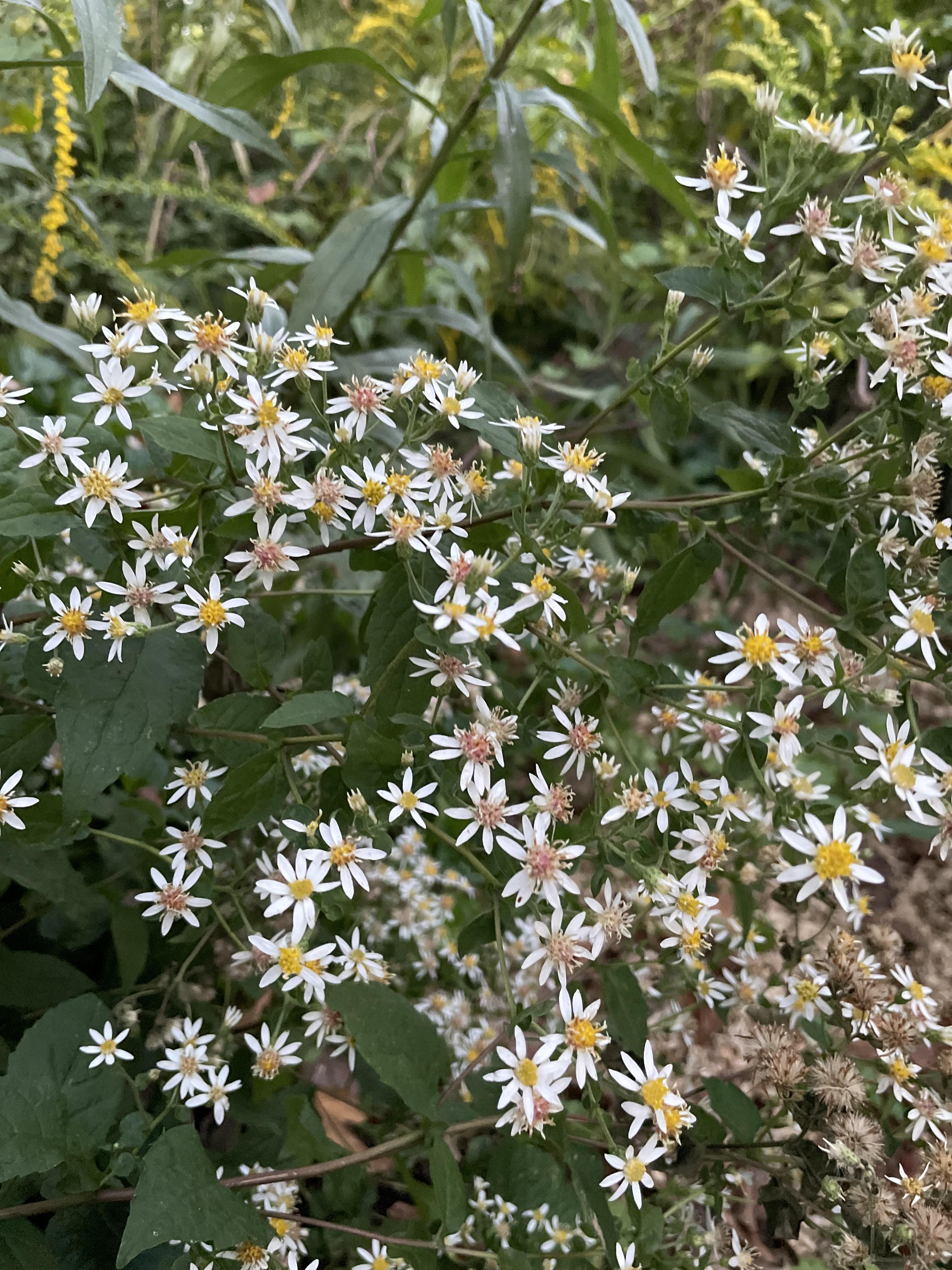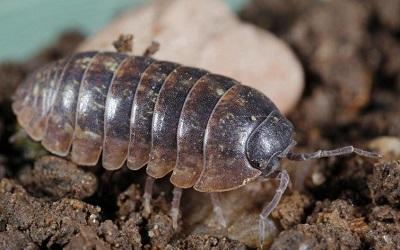
Native white wood aster (Eurybia divaricata) in bloom. Photo: C. Carignan, UME
Sustainable Gardening
- A sustainable, climate-resilient garden is one that is layered with plant diversity - a variety of trees, shrubs, and herbaceous plants. Add more native plants to your landscape as time and budget allow. Now is a good time for planting. [Watch video: A Layered Garden Using Regionally Native Plants.]
- When designing your garden spaces, incorporate recycled and salvaged materials. Find out if you can get old bricks, rocks, tree stumps, or containers from neighbors or another local source.
- Cover bare soil as soon as possible with new vegetation: use cover crops in a vegetable garden or mulch around new landscape plants until they get established and fill in.
Trees & Shrubs
- Avoid planting one type of tree or shrub (a monoculture) when planting a living screen. Diseases and insects are typically host-specific so you run the risk of losing the entire screen if a pest or disease attacks your plants. Select several different types of trees and shrubs, both evergreen and deciduous, to prevent this from occurring.
- In most cases healthy, mature trees and shrubs do not require fertilizers. Woody plants receive nutrients from lawn fertilization if their roots are adjacent to or growing under the turf area. Their roots also take in nutrients from decaying mulches and leaves and from the minerals in the soil.
- Hold off pruning trees and shrubs until later in the fall into the winter. Pruning stimulates growth and any new growth produced now will not have a chance to harden off before winter.
Edible plants
- Plant garlic late September (Western MD) through early November (Eastern Shore and Southern MD) for a late June/early July harvest next year. Plant the cloves root end down; space them 4-6 inches apart and cover with 1-2 inches of soil. Mulch the garlic bed with fallen tree leaves.
- If tomato plants are losing a lot of foliage to disease you can pick fruits and ripen them indoors.
- Harvest pumpkins and winter squashes when the rind hardens (fruits can tolerate a light frost). Cut them from the vine leaving a 4-5 inch handle, handle gently, and store in a cool, dry location until ready to use.
- Time to plant cover crops to protect and improve the soil in your vegetable beds.
- Harvest figs when they soften slightly. Ants may enter the small eye at the bottom of the fruit as the fig ripens.
- Prune out the dead raspberry and blackberry canes that fruited this past summer. Fall-fruiting raspberries and blackberries can be mowed to the ground in late winter.
Flowers
- Leave the large seedheads of black-eyed Susans, coneflowers, and other perennials for birds to feed on over the winter.
- Enjoy goldenrods and asters this month. They are important fall flowers for pollinators.
- Resist cutting back perennial flower stalks in a pollinator garden. Unpruned perennials and ornamental grasses, leaves, and other garden debris are overwintering places for many pollinators and insects we enjoy seeing in the summer. Most insects in the garden are beneficial.
Lawns
- Do you have areas of your lawn that are growing poorly? Consider using other plants that are better adapted to those areas. Refer to The Challenge of Growing a Lawn in Maryland and Lawn Alternatives. For inspiration, these case studies and photos show how Maryland residents are adding more plant diversity in place of turfgrass.
- If you have a lawn consisting of cool-season grasses (tall fescue, fine fescue, Kentucky bluegrass), apply fertilizer in the fall and fertilize according to the UME fertilizer schedule. Make sure to sweep any fertilizer that lands on sidewalks or driveways back onto grassy areas.
- If you are renovating a lawn or repairing bare spots, use recommended cultivars of grass seed.
Insects
- Various types of caterpillars may be found feeding on the leaves of trees at this time of year. Research has shown that this late-season damage is minor to overall tree health and management of caterpillars is usually not necessary.
- You may notice European hornets stripping the bark off shrubs (especially lilac) and trees. This stripping of the bark is usually minor and does no real harm to a shrub or tree. The European hornet is a large yellow and brown hornet that nests in cavities in trees, stumps, wood piles, sheds, etc. and feeds on insects.
- Spruce spider mites are active again on evergreen trees. Monitor for this pest by tapping branches while holding a piece of white paper underneath. Look for moving specks. They can be controlled with ultra-fine horticultural oil (do not use on blue spruce). Follow label instructions.
Diseases
- Powdery mildew may be seen now on many trees, shrubs, and perennials, like pin oak, roses, lilac, phlox, peonies, and monarda. This fungal disease favors high humidity but unlike other fungi does not require wet weather to thrive. It usually appears on plant foliage as a grayish, powdery coating on upper leaf surfaces. When possible select resistant cultivars. No chemical control is necessary.
Miscellaneous
- Poison ivy leaves will begin to turn red this month. Don’t be fooled by their fall color change, the leaves are still very irritating. Do not handle or shred the leaves and do not burn the vines.
- Avoid storing pesticides over the winter in sheds and garages. Cold temperatures can cause these materials to become ineffective. If you have questions about the efficacy of your pesticides call the manufacturer, using the phone number listed on the label. For additional pesticide storage information visit the National Pesticide Information Center website.
Indoor plant and insect tips
Indoor plants

Photo: Joseph Berger, Bugwood.org
- Before moving houseplants back indoors check plants for ants, earwigs, pillbugs, and other nuisance insects. Wash off insect pests or apply a labeled houseplant insecticide to control any plant pests such as aphids, scales, spider mites, and mealybugs.
- Avoid wetting the leaves of fuzzy-leaved plants like African violets. Wet foliage can cause leaf spotting.
- Be careful not to overwater houseplants during the indoor adjustment period which can take several weeks.
- As houseplants that were outdoors for the summer adjust to less light indoors leaf yellowing and drop is possible.
Indoor pests
- Crickets, multicolored Asian lady beetles, boxelder bugs, stink bugs, cluster flies, and other innocuous insects may attempt to enter your home this fall to overwinter. Caulk, weatherstrip, and seal up all cracks, and entry points around your house foundation, vent openings, windows, and doorways to prevent these critters from coming indoors.
- House mice and sometimes field mice may be more noticeable around and in homes due to the onset of cool weather. Keep grass and weeds properly mowed around your house and seal all cracks.